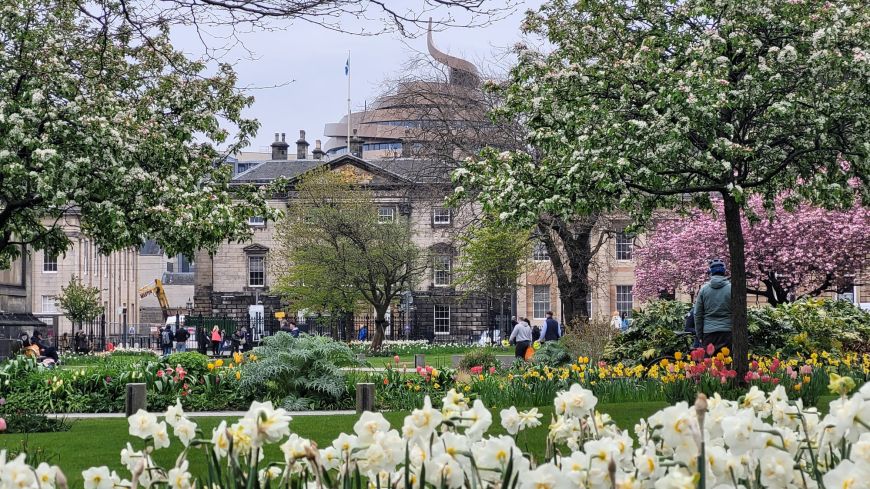
St Andrew Square is one of the most prestigious locations in Edinburgh New Town. A mirror of Charlotte Square, St Andrew Square is located at the East End of George Street in what was the hub of Edinburgh's financial world, but in an area that is now more characterised by its pubs, restaurants, and designer shops.
In the centre of St Andrew Square is its public garden (also square-shaped) with a towering Roman column at its centre. This is the 41-foot tall Melville monument, built in memory of Henry Dundas, 1st Viscount Melville.
The Garden is operated by business marketing organisation Essential Edinburgh on behalf of the various private owners of the surrounding buildings.
The East end of the garden is dominated by the Dundas Mansion, acquired by the Royal Bank of Scotland in 1825 as its head office. Now one of the bank's main branches, this grand building, is fronted by a small semi-circular driveway and gated garden. Inside the main banking hall it has a lovely, blue dome ceiling with multiple small gold star windows.
Next door at 38-39 St Andrew Square is the British Linen Bank building, with its impressive facade of neo-classical figures atop Corininthian columns. Built in 1851-52, to a plan by architect David Bryce, it is now owned by the Bank of Scotland after it acquired the British Linen Bank in 1969.
Edinburgh Transport link
The square remains an important hub for the Edinburgh tram, intercity coaches and local buses.
Bus services use both the street and the main bus station. St Andrew Square bus station, which originally opened in 1957, with four stances, closed in 2000 for a £4m refurbishment and re-opened in 2003 with many upgrades. Pedestrian entrances to the bus station are at Elder Street and North St Andrew Street (at the north east corner of St Andrew Square).
St Andrew Square was originally designated as a main interchange for the Edinburgh tram network, on the first phase of the line for which work started in 2008. It opened in 2014 as the terminus for the line from Edinburgh Airport.
The Square is very close to Waverley station, Edinburgh's central railway station.
A new garden
Following a £2.6 million investment in the square, by the City of Edinburgh Council, in partnership with Scottish Enterprise Edinburgh and Lothian, the gardens re-opened on 4 April 2008 with two new entrance gates in the south-west and northeast corners, curved footpaths linking the new entrances, a reflective pool in the South West of the garden, mood lighting, and a café pavilion. The Melville monument also underwent repair.
The improvements were warmly welcomed by people in Edinburgh, particularly since unlike most New Town gardens that are restricted only to local residents, the revamped St Andrew Square garden is now open to the public.
New Town design
New Town architect James Craig (1744-1795) originally conceived St Andrew Square as being the mirror to George Square (subsequently re-named Charlotte Square) with St Andrew's Church looking out from the far East side of St Andrew Square down the length of George Street to its twin St George's Church (now West Register House).
However, businessman Sir Lawrence Dundas bought the land in St Andrew Square before Craig and built a Palladian town house on the spot, Dundas House which is now owned by the Royal Bank of Scotland Group. St Andrew's Church was built part way along George Street instead.
Festival Venue
Due to its central location, St Andrew Square often has hosted Fringe shows and pop-up venues.
The Square has become a focal point of Edinburgh's Winter festivals from mid-November to early January.
It hosts a Christmas Tree maze and Santa's grotto, with an abundance of Christmas lights.
For several years, it hosted a doughnut-shaped, elliptical ice rink around the Melville monument. That ended in 2019 due to impact of the rink and crowds on the park's trees and lawns.
The Name
St Andrew Square is sometimes mistakenly written as St Andrew's Square or St Andrews Square (see Three Tram Options, One Square blog).
Return to this page directly via StAndrewSquare.com.

